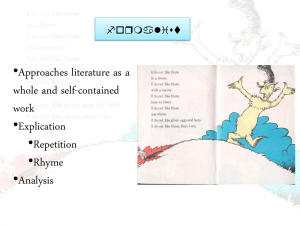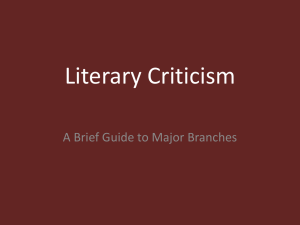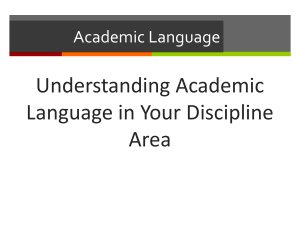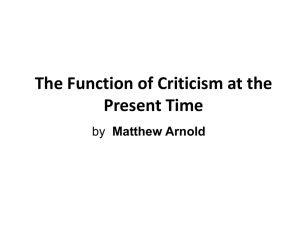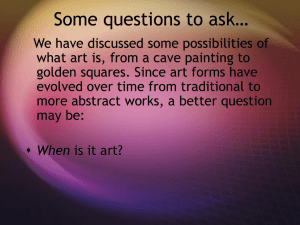Andrea McCatty - UCF College of Education and Human Performance
advertisement
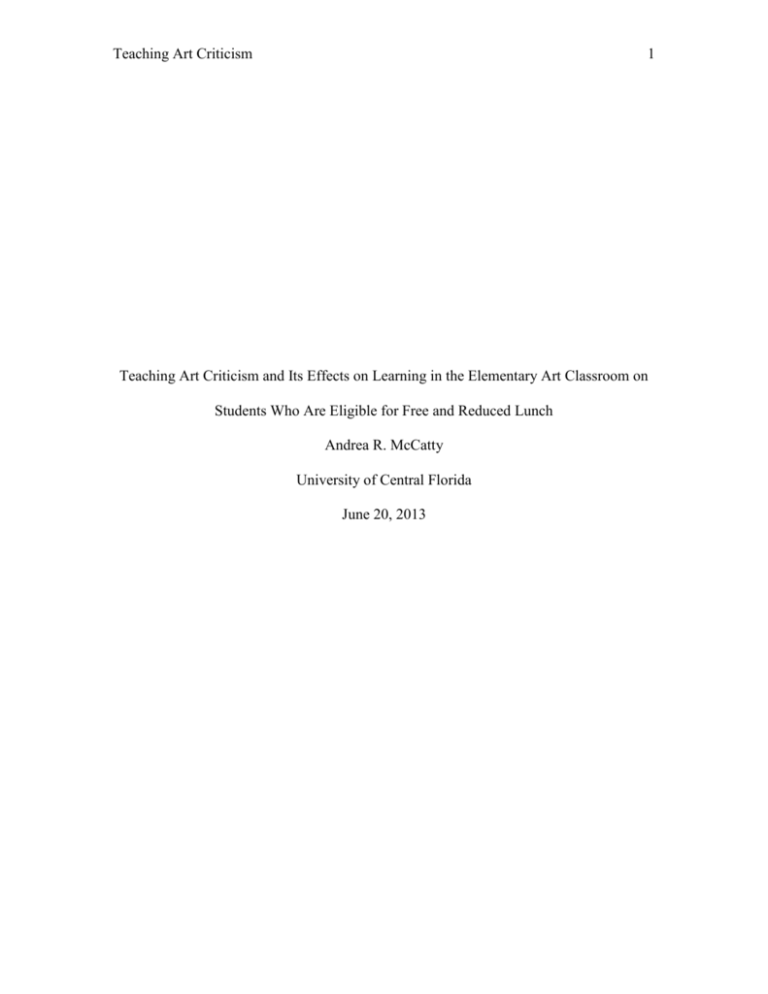
Teaching Art Criticism 1 Teaching Art Criticism and Its Effects on Learning in the Elementary Art Classroom on Students Who Are Eligible for Free and Reduced Lunch Andrea R. McCatty University of Central Florida June 20, 2013 Teaching Art Criticism 2 Introduction Arts education has been pushed to the sidelines of curriculum, especially in lower income area schools. Visual arts has been on the chopping block for years, looked at as expendable due to the limited budgets and the pressure of high stakes academic accountability in other subject areas. The result is a “progressive degeneration” of authentic arts education for students who cannot afford opportunities elsewhere, which reduces these students capacity to compete with more affluent students, widening the achievement gap (Holloway & Krensky, 2001, p.354). Purpose The purpose of this study if to determine if teaching students the methodology of art criticism throughout their curriculum, through the use of contemporary exemplars will have a positive impact on the students’ achievement in the visual arts. Closing the achievement gap between students who are eligible for free and reduced lunch and students who are not eligible is a desired result of this assessment study. Questions 1) What effect will teaching students methodology of art criticism and critique have on student achievement? 2) Will teaching students, who are eligible for free and reduced lunch, methodology of art criticism close the achievement gap with students who are not eligible for free and reduced lunch? 3) What impact will the use of contemporary exemplars have on student achievement? Teaching Art Criticism 3 Current Condition / Status There is a trend in recent years showing a gap in achievement between socioeconomic challenged students and students who come from higher income households. Based off the most recent 2008 NEAP Visual Arts assessment of eight graders, students who were eligible for free and reduced lunch scored significantly lower than students who were not eligible for free and reduced lunch. Students who were eligible for free and reduced lunch averaged a score of 133, twenty-seven points lower than students who were not eligible, scoring on average 160 (See Appendix M). Based on data collected from principals and art specialists in the 2009-10 school year, only eighty percent of schools who had seventy-six or more percent of their students qualifying for free and reduced lunch offered visual arts to their students, in comparison to schools who have twenty-five percent or less of their students qualifying for free and reduced lunch, offered visual arts at ninety-two percent of their schools. Rationale Socio-economic status has proven to be a predictor of students’ achievement more times than not. Students coming from a low socioeconomic background have consistently been lower achievers in academic standing, visual arts included. It is important to find the disconnects for these students in order to promote success for every student regardless of socioeconomic standing. Hypothesis After all data has been collected and organized, the results of my study, with any luck, will support the following: Teaching students the methodology of art criticism will have a positive effect on student achievement. Teaching the methodology of art criticism Teaching Art Criticism 4 will close the achievement gap between students who are eligible for free and reduced lunch and students who are not eligible for free and reduced lunch. The use of contemporary art exemplars will enhance student learning by increasing students’ understanding through enhanced engagement, thus increasing students’ achievement on the assessment. Through the use of contemporary exemplars along with the understanding of the method of criticism, race will not be a predictive factor in student achievement. Operational Definitions Free and Reduced Lunch Program: The National School Lunch program provides free lunches to students whose family income is below 130% of the federal poverty line; it offers reduced-price lunches to students whose family income is between 130% and 185% of the poverty line. Lunch program participation is often used as an indication of family income levels at the school (Keiper, Sandene, Persky, & Kuang, 2009, p. 20) Contemporary Art: Works of art created in the past thirty years. Bundled Assessment: Multiple measure assessment consisting of various forms of assessment (Brewer, 2011). Exemplar: An ideal example of something, worthy of imitation. Art Criticism: Spoken or written talk about artwork (Feldman, 1994, p. 1) Describe: First stage of art criticism. Information gathering stage: artist, title, medium, date of work, and country of origin. Utilize language of line, shape, color, and texture. Critic should employ neutral, unloaded, value-free language. (Feldman, 1994, p. 25). Analyze: Second stage of art criticism. Dealing with visual evidence, juxtaposition and combination of formal elements; line, shape, color, and texture (Feldman, 1994, p. 28). Teaching Art Criticism 5 Interpret: Third stage of art criticism. Search for meaning, a statement that makes our descriptive and analytic observations cohere, making meaning of critical exploration from stages one and two of art criticism (Feldman, 1994, p. 30). Judge: Form an opinion or conclusion about piece of work of art. Estimating the value in relation to another work of art. Is it successful? (Feldman, 1994, p. 36) Formalism: Concern or excessive concern with form and technique rather than content in artistic creation (Feldman, 1994, p. 38). Expressivism: An artworks capacity to communicate feeling and ideas honestly, vividly, and forcefully (Feldman, 1994, p. 39) Instrumentalism: Artworks capacity to serve an institution that is seen as greater than Art, religious, government, political, business, etc. (Feldman, 1994, p. 40). Mixed Method Research: an approach to inquiry that combines or associates both qualitative ad quantitative forms (Creswell, 2009, p. 4) Review of Literature The first study / article to be reviewed is “The Nation’s Report Card: Arts 2008 Music & Visual Arts”. The 2008 NAEP visual arts assessment included four sections that measured students’ ability to respond to and create visual art. The responding portion asked students to describe and analyze works of art, which therefore demonstrated their knowledge of media and techniques, visual organization, cultural contexts of artworks, how art conveys meaning, and the relationship between form and function in design. The creating portion assessed students ability to communicate through works of art, create Teaching Art Criticism 6 solutions to visual problems, generate ideas for design, and create works of art (Keiper, Sandene, Persky, & Kuang, 2009, p. 20). A comparison between the 1997 and 2008 could not be made due to some changes in scoring procedures, however comparisons can be made on the multiple-choice portion of the assessment which only showed a significant difference on one question about a compositional feature of medieval artwork (Keiper, Sandene, Persky, & Kuang, 2009, p.36). The National School Lunch Program (NSLP) offers free / reduced lunch to students who are eligible, being eligible for this program indicates living at or below poverty level (Keiper, Sandene, Persky, & Kuang, 2009, p. 35). Results from the 2008 NEAP showed that on average students who were eligible for free or reduced lunch scored twenty-nine points lower on the responding portion of the assessment than students who were not eligible. Students who were eligible also scored nine points lower on the creating portions, compared to students who were not eligible for free/reduced lunch (Keiper, Sandene, Persky, & Kuang, 2009, p. 22). This information aligns with the findings from “Arts Education in Elementary and Secondary Public Schools”. Students who come from low socioeconomic backgrounds are offered visual art instruction twelve percent less than students who come from a more affluent socioeconomic background (Parsad & Speigelman, 2012, p. 28). How are students to gain a deep understanding of visual arts with no consistency in the program, which, in turn denies them of the opportunity to build upon knowledge from year to year? Differences in performance were also found based on race and ethnicity. Finding from the 2008 NAEP data website, National Public school students who were White preformed best over all with an average score of one-hundred and fifty-nine, followed by Teaching Art Criticism 7 Asian/Pacific Islander students who scored an average of one hundred and fifty-four, followed by Hispanic students scoring one hundred and thirty-three, and performing lowest were Black students with an average score of one hundred and twenty-eight (See Appendix N), (National Center for Educational Statistics, 2008). The next articles to be reviewed are Harwell and LeBeau’s “Students Eligibility for a Free Lunch as an SES Measure in Education Research”, followed by Sparks’ “NAEP Seeks to Test New Measure of Student Poverty”. Eligibility for the National School Lunch Program has, for years, been a predictor for students’ socioeconomic status, becoming deeply ingrained in K-12 education in the United States. Originally the NSLP was created with the intentions to improve student nutrition, especially among the poorest of the student population, the desired result being an increase in student learning. Evidence has been found to support these results, although the increase of student learning has left much to be desired. One of the major outcomes of NSLP is students’ eligibility being used as a predictor for socioeconomic status in educational research. Its popularity in educational research may be attributed to educational researchers having easy access to students’ eligibility for free and reduced lunch through the NSLP. Despite its accepted and frequent use, this variable possesses important deficiencies that suggest the need for additional predictors and measures of socioeconomic status (Harwell & LeBeau, 2010, p.128). Sparks’ “NAEP Seeks to Test New Measure of Student Poverty” is practically a continuation and remedy to Harwell’s and LeBeau’s found shortages. Sparks’ reports that the NAEP is aiming to get a clearer picture of how students’ home and community resources affect their academic achievement by building a comprehensive new way to Teaching Art Criticism 8 gauge socioeconomic status. New measures of student socioeconomic status are being developed by the National Assessment Governing Board and the National Center for Educational Statistics. Eight researchers in the areas of education, economics, statistics, human development, and sociology were commissioned to develop new indicators of poverty beginning in 2010. The new measures and predictors of socioeconomic status look beyond family income, which currently determines a students’ eligibility for free and reduced lunch, and now looks at family, community, and school supports for learning. Current measures that have shown to be linked to educational access are: family income, parent’s level of educational achievement (See Appendix R), parents’ employment status, how long a child has lived in the United States, number of family members are living with a child, how many adults residing in the home are employed, internet availability, and number of books in the home (See Appendix S). Potential expanded indicators of socioeconomic status will look at Family: family structure, stability, and the presence of extended family; Neighborhood: concentration of poverty or linguistic isolation, percentage of unemployed adults, availability of museums, parks, and safe walking routes; School: the socioeconomic status of student population; Physical Stressors: rates of illness or environmental problems; Psychological Stressors: level of crime in school and community; and Psychological Protectors: student perception of parent involvement and expectations (Sparks, 2013, p.7) The governing board plans to present the proposed socioeconomic status indicators at the annual meeting of the American Educational Research Association before piloting their use in 2014, results to be reported in 2015. Teaching Art Criticism 9 The next article review is a study that was conducted by teachers in Berkeley, California at Long Fellow Arts and Technology Magnet Middle School. Longfellow if one of three middle school in the Berkeley Unified School District and located in the plains of Berkeley, which is predominately African American and a relatively poor area. Longfellow opened in 1922 as an elementary school and has been wrestling with the issue of desegregation since the 1960’s when Berkeley made headlines as the first school district to voluntarily desegregate using a bussing system. In the 1990’s the School Board declared Berkeley as an open enrollment school district in the mid 1990’s when parents became fed up with the long commutes. Shortly after, Longfellow reopened as a state-ofthe-art arts and technology magnet school As a new school with a focus on education in and through the arts, teachers and administrators had to develop forms of assessment that captured how the arts enhanced education. Reports were needed for administrators at the State and District level. These reports were also needed to convince parents of the advantages of an arts oriented curriculum seeing as parents now had the option to send their child to any school in the district. As a result, the school contacted ETS (Educational Testing Service) in 1998 to have the NAEP visual arts assessment piloted at Longfellow. ETS selected the Bearden Collage Block to administer to students at Longfellow Middle School. Teachers who were present while ETS staff administered the test indicated critical procedural problems of how the test was presented to students. Longfellow students had never been given such a small amount of time to create such a large piece of work. This caused some students to ignore time constraints in order to finish their artwork. Consequently the writing portion was rushed and / or incomplete. Teaching Art Criticism 10 Teachers agreed the test itself was valid but questioned the procedural reliability in certain areas. Longfellow teachers and administrators met with an assessment consultant to see how the NAEP could be reconfigured and rescored so it could provide a valid and reliable portrait of student achievement. They were particularly interested in answering two questions, “Was there anything distinctive about student learning in art? And, Did student participation in visual art class contribute to general academic success?” (Diket, McCulloch, Siegesmund, 2001, p. 49). Holistic scoring was abandoned and the scoring factors Analyze, Describe, and Interpret were renamed and treated as independent variables. Analyze became exploring, which meant to capture data as the gathering task of perception. Describe became Attending, which meant to identify visual materials, gestures, elements and principles of design that convey a feeling or specific visual quality. Interpret became Relating, which meant to assemble all evidence to support meaning. The variable of Responding was added to keep track of whether students had addressed the problem as it was posed, this allowed judges to still score the answer for exploring attending and relating even if the answer was not relevant to the question. The last variable, Sustaining, was added due to the assumption that the during the NAEP assessment students will work with ideas that emerge through the responses of individual questions. With this variable students are given credit for ideas that are introduced and developed further in other areas of the assessment (Diket, McCulloch, Siegesmund, 2001, p. 49). Longfellow arts teachers administered the revised version of the assessment in May of 2000 to four art classes that were composed of seventy-one seventh and eighth Teaching Art Criticism 11 graders. Through the use of the new scoring rubric they created test scored ranged from 15-48 out of 54. The average score was 28.2, in which the level of student achievement corresponded to the 1997 NAEP national test results (Diket, McCulloch, Siegesmund, 2001, p. 50). Other findings were that this assessment was not a predictive model for student achievement in non-art subject areas and students who felt personally invested performed better. An important and unexpected finding was that socioeconomic status was not a predictor of achievement on this test; unlike the 1997 and 2008 NEAP reported findings (Keiper, Sandene, Persky, & Kuang, 2009) The new scoring rubric had direct implications for how the visual art faculty should structure their curriculum. It was found that students who scored higher on the attending (formerly describe) and sustaining scored higher on the assessment. This assessment measured a form of students’ thinking that was not captured in assessment practices in other subject areas. These cognitive skills are not the outcome of art instruction; rather, if the development of cognitive skills are the goal of instruction then curricular objectives and pedagogy need to be aligned to achieve this goal. Which implicated that, “Teachers should be guiding students through visual arts lessons that emphasize how visual materials are shaped in qualitative relationships that are indicative of feeling and emotion.” It also implicated that, “Teachers should provide opportunities for students to construct and analyze meaning in visual qualitative relationships that are created by the manipulation of visual media and that students should have opportunity to reflect about their own thinking as they are making art” (Diket, McCulloch, Siegesmund, 2001, p. 52). This idea is supported by the 2008 NAEP findings, showing that students who talked about artwork everyday scored significantly higher than students who hardly Teaching Art Criticism 12 ever or never talked about artwork (See Appendix O), (National Center for Educational Statistics, 2008). Longfellow teachers and administration discovered the critical thinking skills necessary to do well on the re-visioning NAEP. These finding align with the 2012 Diket article, “What did Students Do in Their Critical Analysis of 5 Mother/Child Artworks Presented in the 1997 and 2008 NAEP Arts with Whatever They Knew about Art, from Wherever Opportunity to Learn Source?” Diket presented necessary thinking strategies to perform well on the 2008 NAEP that conformed to specific features of various critical theories, including Edmund Feldman’s Critical Method of Art Criticism, which is comprise of four stages: describe, analyze, interpret, and judge (Diket, 2012). The next article to be reviewed is “The Perfect Marriage? Language and Art: Criticism in the Hong Kong Public Examination Context”. Hong Kong has recently undergone an educational reform. In response, art education has made various changes in their curriculum. One major change is the inclusion of art critique as a required component of public examination. Students are required to write critical responses to artwork exemplars and develop a portfolio that consists of school-based written art critique and visual art creation. Hong Kong planned to implement this new portion of examination in the 2012 school year. With the introduction of art curriculum changes, a major concern has surfaced and questions have arisen about the role of written language in critiquing art. Since art critique relies greatly on writing, some fear that written critique will be assessed based on a student’s written language abilities rather than their critical abilities. A pilot study was done in Hong Kong in 2007, including seventeen senior secondary Teaching Art Criticism 13 schools. The students involved were to complete an art critique paper, given forty-five minutes to respond to one of five questions requiring students to analyze, interpret, and evaluate an artwork exemplar. The study used a criterion-based method to measure students’ performance on the assessment. The evaluators used three levels of achievement to judge students writing, level three being the highest. Students and their teachers also partook in post assessment interviews (Wong, 2012). These in-depth interviews showed concern by the teachers that written critique would be assessed based on a student’s written language abilities rather than their critical abilities, and as a result students’ scores would suffer in the critique assessment. Some teachers talked about how this assessment may stifle student creativity. Teachers also feared that students who had low skill levels for writing would give up taking art all together in response to assessing art critique. Students, on the other hand, found the difference between assessing art critique, which focused on students’ art knowledge, and assessing written skills, which focused on composition rather than content, to be distinctively different, but admitted that having better writing skills would be helpful in the writing portion of the art critique (Wong, 2012). Results showed that forty-three percent of students who partook in the pilot achieved a level three, while only three percent achieved a level one. The remaining fiftyfour percent of students achieved a level two. Scores ranges between eighty-three percent and twenty-five percent, the average score for students was fifty-eight percent. From the results of the study, Wong (2012) found that language in the art critique pilot examination did not influence the interpretation of idea. Wong (2012) also found the differentiation in student and teacher opinion to be of concern. Perhaps, after years of Teaching Art Criticism 14 implementation, and enhanced art critique abilities for both the teachers and students there will be less of a contradiction in opinions of written language and its effect on art critique. Arts Education in the United States have been more focused on the method in which to teach art criticism rather than using it as a method of assessment. The main issues have been how to develop a model of classroom art talk from both a teaching and learning standpoint and then how to apply this art talk in a classroom setting. The importance of verbal language has been assumed and the issue of written language, such as brought up in Hong Kong, has seldom been raised (Wong, 2012). Artworks use visual forms to express and communicate meaning, verbal language can be used to interpret and translate that meaning (Wong 2012). In a school classroom, verbal language, spoken and written, is the method used to show learning in not only art, but nearly every subject area. Concern over written language should not deter art educators as using it as a means to assess students’ art criticism. Students will rise to the expectations of teachers, in turn teachers should not be expecting the worst. When teachers gain a better understanding of criticism they will be better prepared to implement it in a classroom setting, students will be able to eventually become successful. If spoken and written art criticism is taught beginning in primary grades, by the time they reach secondary level written language will not be an issue in art critique, it will just be a means to the end. Teaching written critique could even have a positive impact on students writing skills in all other subject areas, but that is a whole other study all in itself. Teaching Art Criticism 15 Hong Kong has adopted the Feldman method of art criticism for teaching primary and secondary grades. Hong Kong Curriculum Development Council suggests five areas of focus when approaching artworks, “literal description, comprehensive feeling, formal analysis, interpretation of meaning, and value judgment” (Wong, 2012). These areas can be directly related to Feldman’s method of critique, which is describe, analyze, interpret and judge. R. Diket also referenced Feldman’s methodology as a means to teach critical strategies in her 2012 article. A related issue brought up in this article is the debate between modernist and post modernist views of contemporary art and criticism. Speaking from a modernist viewpoint, “meaning is universal and context free” (Wong, 2012). The modernist view puts emphasis on visual qualities created by the organization of visual elements, without considering context. The post-modern view, on the other hand, is dependent on socialcultural context of both the artwork and the viewer. In this view art can only be understood in its social-cultural relationships; and viewers of this art are creating meaning based on their own social-cultural experiences and understandings (Wong, 2012). Since students learn better when they can connect with the subject, or apply background knowledge, the post-modernist view is the way in which students should interpret contemporary art. The next article to be reviewed is Arts at the Core: Recommendations for Advancing the State of the Arts Education in the 21st Century. This article states, “One of the greatest challenges for this nation is to ensure that achievement gaps in all areas of education among racial and ethnic minorities are eliminated” (College Board, p.11, 2009). It is believed that greater access to arts education can serve as an effective tool in Teaching Art Criticism 16 closing the achievement gap, but arts education is not equally accessible or available to all students. Data has shown that students who come from low-income households are often the students who are offered fewer opportunities to partake in “consistent, highquality” arts education (College Board, p.11, 2009). NAEP data states that students who receive art instruction at least once a week scored significantly higher than students who did not received art (See Appendix P), (National Center for Educational Statistics, 2008). Reasons for the lack of opportunity are accredited to the deficiency of funding and financial resources. In low income areas the rate of teachers turnaround is higher than in high income areas due to lack of resources and a more challenging work environment, keeping highly qualified teachers becomes a challenge. Also, when a student reaches the middle and high school level, many will be placed in remedial academic courses in place of electives and will not be given the opportunity to take arts courses, which are considered to be an elective (College Board, p.12, 2009). This article touches briefly on multiculturalism as an important aspect of a quality arts curriculum. “Studying diverse art forms and multicultural artists would increase equal educational opportunities for students from diverse racial, ethnic, gender, religious, social class and cultural groups, and potentially increase academic engagement among these groups”(College Board, p. 12, 2009). When a student can make personal connection or relate background knowledge with new subject matter and information, they will have a greater understanding of it. “Art and music require the use of both schematic and procedural knowledge and, therefore, amplify a child’s understanding of self and the world” (College Board, p. 12, 2009). “Curriculum should be rooted in the life experiences of students and explore how personal perspectives are intertwined with Teaching Art Criticism 17 broader society” (Feldman & Woods, 1981, p. 80). By using contemporary, multicultural exemplars students will have an abundance of opportunities to do so. The use of contemporary art is brought up in this next article, “Substantive Art Integration Equals Exemplary Art Education” by Julia Marshall. Marshall (2006) states that, “Contemporary postmodern art offers new ways for understanding and making art” (p.17). She describes current art as eclectic; taking many forms, styles and approaches; giving students more opportunity to find something they connect with and that is relatable and significant to their lives. Marshall (2006), goes on to say that contemporary art often quotes images and styles from visual culture and global visual traditions, as well as from Western art history (p.17). This statement is visually supported in the Exemplars, Faith Ringgold’s Dancing at the Louve and Kihinde Wiley’s Napolean Leading the Army over the Alps (See Appendix K&L). Contemporary art is conceptually based, and it emphasizes ideas. Contemporary art is focused not on pure form or aesthetic pleasure but on making meaning or reinterpreting meaning. Marshall (2006) states that, “Contemporary art promotes an art education that: foregrounds thinking and conceptualization, building conceptual and technical skills simultaneously; utilizes current art strategies; appropriates or quotes images from visual culture and art; looks at art in an anthropological way— examining how art expresses cultural values and meanings; teaches a myriad of techniques, materials, forms and art genres, including experimental and inter- disciplinary genres; has meaning making as its primary objective.; and current art focuses on content from all areas of life, therefore, it also calls for curriculum integration (p.18). Marshall’s review of contemporary art characteristics Teaching Art Criticism 18 and benefits supports the use of contemporary exemplars in the following proposed assessment. Methodologies Sample A total of approximately 50 fifth grade students will be assessed, 25 students from school A and 25 students from school B. Both schools A and B will have at 75% of their student population eligible for free/reduced lunch. The teacher from school A will have taught and consistently focused on the methodology of art criticism (describe analyze, interpret, judge) throughout the year alongside the visual art curriculum. The teacher from school B will have not taught or implemented art criticism throughout the year. Research Design I currently work at a school with one hundred percent of the student population eligible for free breakfast and lunch. My previous school was the same. Students at both of these schools have had a very unstable visual arts education from year to year with programs being cut, years without visual arts, to be reinstated half -time with a new teacher, followed by a different instructor the next year. NAEP data showed that students who receive art instruction from a fulltime certified art specialist score significantly higher than students who are not (See Appendix Q), (National Center for Educational Statistics, 2008). With a fairly new principle understanding the importance of a quality arts education, I am receiving all the support I need to educate these students, but there is a lot of lost time to make up for. In the Fall semester of 2011 I took ARE 6195, Teaching Art Appreciation with Interdisciplinary Strategies. This class changed they way my students and I talked about Teaching Art Criticism 19 art, it changed the way my students and I look and responded to art, and it changed the way my students and I created and reflected on their work. The class reshaped the dynamics of my classroom. I am taking what I have learned about art criticism and combining it what I have learned about assessment in two research design courses. This research is a quasi-experimental research design that will use a mixed method approach in gathering and analyzing both qualitative and quantitative data. Students at school A will receive treatments using instrument (See Appendix J). The Art Teacher at School A will utilize this treatment with every lesson; it can be used for an artist’s or student’s artwork. Students will be assessed twice, at the beginning of the year and at the end of the year, to measure independent achievement and to see how much growth that has been made by students who received the treatment in comparison to students who did not receive the treatment. Student demographic and teacher profile data will be used to further compare separate variables to determine if relationships exist between them. Instrumentation A demographics survey will be given to students to gather information on economic status, ethnicity/race, and gender (See Appendix A). A teacher profile survey will be given to the teacher to gauge educational experiences and the curriculum they implement (See Appendix B). The assessment will include and multiple choice / matching portion based on contemporary exemplar (See Appendix C), a critique portion (See Appendix D), and a planning and final creating portion (See Appendix E & F). Rubrics will be used to assess the students’ art criticism (See Appendix G) and drawing (See Appendix H & I) portions of the assessments. Teaching Art Criticism 20 Procedural Details This study will be conducted during the course of one school year, August until May, at two separate Orange County public schools. Fifty fifth-grade students, living in the greater Orlando area of Florida will participate in a pre / post bundled assessment. The pre and post assessment will be the same with the exception of the exemplars. The pre-test will be given in August, and the post-test will be given in May. Day One – Pre-assessment o Students will fill out demographics survey; teacher will fill out teacher profile. o Multiple choice portion of assessment will be given Day Two – Pre-assessment o Art criticism writing portion Day Three – Pre-assessment o Planning and Final Creating Portion Day One - Post -assessment o Multiple choice portion of assessment will be given o Art Criticism writing portion Day Two – Post- assessment o Planning and Final Creating Portion Data Analysis Once all data has been collected, data will be evaluated and compared, focusing on finding correlations between curriculum, achievement level, and students’ eligibility to receive free and reduced lunch. Correlations between curriculum, achievement level, and ethnicity/race and gender will also be looked at. Once all data has been analyzed all the hypothetical questions will be answered. Assessment / Pilot This assessment is modeled after the portrait portion of the 2008 NAEP and portions of Brewer’s Bundled Assessment (Brewer, 2011). The assessment will consist of four separate, but relatable, sections. Section One – Multiple Choice /Analysis; Section Teaching Art Criticism 21 Two – Art Criticism; Section Three – Creating, Planning self-portrait sketch; and Section Four – Creating, Final self-portrait drawing. Two contemporary artists’ paintings are used as exemplars, Kehinde Wiley and Faith Ringgold. There will be a pre and post assessment given. The pre-assessment will cover a three-day period; the post-assessment will cover a two-day period. In Section One students will study the two exemplars (See Appendix K & L) and answer eight multiple choice questions about the works (See Appendix C). Students will have thirty minutes to study the works of art and answer all eight questions. Questions are directly related to the exemplars. Section Two is the Art Criticism portion of the assessment. Students will choose one of the two exemplars to critique. Students will describe, analyze, interpret, and judge their work of choice on the sheet provided (See Appendix D). Students will be given sixty minutes to complete this section of the assessment. Students’ responses will be graded using a rubric (See Appendix G). In Section Three, the creating / planning self-portrait pencil sketch, students are asked to sketch one idea to later be finalized. Students should include characteristics that portray self-identity. Students should reference the exemplars used for section one and section two. The sketch should be relatively complete and represent a cohesive idea. Students will be given thirty minutes to complete this section of the assessment (See Appendix E). A rubric will be used to assess the sketch (See Appendix H) In Section Four, students will be asked to create a finalized self-portrait using the insight and knowledge they have gained from previous sections. The final self-portrait should be a finalized version of the planning sketch (See Appendix F). The drawing Teaching Art Criticism 22 should show the student as the main subject and the student’s personal identity. It should be an organized, cohesive, work that uses good craftsmanship. The final drawing should also show evidence of the student’s understanding of the elements of art and principles of design. Students will be given a pencil, eraser, and crayons to finish this work. Students will be given sixty minutes to complete this section of the exam. The final self-portrait will be assessed using a rubric (See Appendix I). Implication for Teaching “We assess a situation as the basis for deciding a future course of action” (Pistone, 2002, p.3). If and when this assessment was implemented the results would shed some light on the effect of teaching students art criticism and its relation to all students achievement in visual arts. If teaching art criticism proves to have a positive effect on student achievement in all students, including students who are eligible for free and reduced lunch, teachers, especially those who teach in low income areas, will need to begin incorporating it into their visual arts curriculum. Art criticism could be the method of teaching that will close the achievement gap between student who are eligible for free and reduced lunch and those students who are not eligible. Teachers will need professional development in the area of art criticism, as they will need to fully understand it before they can effectively teach it. If students show a high rate of success on this assessment, the variable of contemporary art will also have to be looked at. When students are able to relate to the exemplar, student engagement is usually higher and a higher level of understanding can be achieved. As a result, teachers should reevaluate the exemplars they are utilizing in their classrooms. Teaching Art Criticism 23 Results This research proposal has resulted in a four-section assessment tool that can be used to gather data. The rubrics created for this assessment can be used as a means to assess the data collected, and the student demographics survey and teacher profile can help to compare and contrast achievement gains and gaps in student achievement to configure answers to the hypothetical questions stated previously. The contemporary exemplars used in this assessment could also be looked at as a variable that effected student achievement. Since this assessment has not yet been implemented, no results are available to be included in this proposal. Conclusion I have moved past the point of debating whether or not to assess the arts. Assessment is more than a way to prove visual arts place in education, it is the way to a quality, authentic, and effective visual arts education. My research has shown the evervaluable critical thinking skills that can be gained, and perhaps a means to attain them. It is clear through my experience in teaching and research, students who come from low-income backgrounds struggle to make the same academic achievement gains as student who comes from a more affluent background. The reasoning is varied, but the result is the same. Since I teach at a school with one hundred percent of the student population fitting into the category of low-income backgrounds it is my duty as an educator to find a means to close this achievement gap and make success available to every single student, regardless of their socioeconomic status. Every student can learn, just not on the same day or in the same way. ~George Evans~ Teaching Art Criticism 24 References Brewer, T. (2011). Lessons learned from a Bundled Visual Arts Assessment. Visual Arts Research, 37(1), 79-95. College Board. (2009). Arts at the core: recommendations for advancing the state of arts education in the 21st century. Retrieved on June 8, 2012 from http://advocacy.collegeboard.org/sites/default/files/arts-task-force-report.pdf Creswell, J.W. (2009). Research Design: Qualitative, quantitative and mixed methods approaches (3rd ed.). Thousand Oaks: Sage. Chapter One. Diket, R. (2012). What did Students Do in Their Critical Analysis of 5 Mother/Child Artworks Presented in the 1997 and 2008 NAEP Arts with Whatever They Knew about Art, from Wherever Opportunity to Learn Source? Paper presented at AERA 2012, Vancouver, BC. Diket, R., McCulloch, S., & Siegesmund, R. (2001). Amending a performance assessment for middle school art students. National Art Education Association, (43) 1, 45-56. Feldman, E. B., & Woods D. (1981). Art criticism and reading. Journal of Aesthetic Education, (15) 4 , 75-95. Keiper, S., B.A.Sandene, H. R. Persky, and M. Kuang. (2009). The Nation’s Report Card: Arts 2008 Music & Visual Arts (NCES 2009-488) National Center for Education Statistics, Institute of Education Sciences, U.S. Department of Education, Washington, D.C. Available at: http://nationsreportcard.gov/arts_2008/ Marshall, J. (2006). Substantive Art Integration Equals Exemplary Art Education. Art Education, (59)6, 17-24. National Center for Educational Statistics, Institute of Education Sciences, National Assessment of Educational Progress. (2008). Visual Arts Assessment. Retrieved from http://nces.ed.gov/nationsreportcard/naepdata/ Parsad, B., and Speigelman, M. (2012). Arts Education in Public Elementary and Secondary Schools: 1999-2000 and 2009-10 (NCES 2012-014). National Center for Education Statistics, Institute of Education Sciences, U.S. Department of Education. Washington, DC. Pistone, N. (2002). Envisioning arts assessment: a process guide for assessing arts education in school districts and states. Washington, DC: Council of Chief State School Officers. Teaching Art Criticism 25 Ringgold, Faith. (1991). Dancing at the louvre. [Oil on canvas]. Private collection. Retrieved from: http://www.faithringgold.com/ringgold/d11.htm Sparks, S. D. (2012). NAEP seeks to test new measure of student poverty. Education Week. (32)14, 6-8. Wiley, Kehinde. (2005). Napolean leading the army over the alps. [Oil on canvas]. Brooklyn Museum, Brooklyn. Retrieved from: http://www.brooklynmuseum.org/opencollection/objects/169803/Napoleon_Leadin g_the_Army_over_the_Alps Wong, S. L. (2012). The perfect marriage? Language and art criticism in Hong Kong public education. (Unpublished paper). Teaching Art Criticism 26 Appendix A Student Background Survey Name:____________________________ School:_____________________________ Answer the following questions to the best of your knowledge. 1) What is your gender? O Female O Male 2) What is your race/ethnicity? O White O Black / African American O Hispanic / Latino O Asian / Pacific Islander O Other ___________________ 3) What is your Age? O 10 O 11 O 12 O 13 O Other _________ 4) Is this your first time in fifth grade? O Yes O No 5) Have you ever repeated a grade? O Yes O No If yes, what grade? ________ 6) Who do you live with? O Mother and Father O Mother only O Father only O Grandparents O Foster parents O Other ______________________ 7) What is your mother’s highest level of education? O Did not finish high school O High school graduate O Some education after high school O Graduated from college 8) What is your mother’s highest level of education? O Did not finish high school O High school graduate O Some education after high school O Graduated from college Teaching Art Criticism 9) How many different schools have you attended since Kindergarten? O Only this school O Other _______ 10) Did you have art class when you were in: Kindergarten? 1st Grade O Yes O No 2nd Grade O Yes O No 3rd Grade O Yes O No 4th Grade O Yes O No 5th Grade O Yes O No 11) Is there artwork displayed in your home? O Yes O No O If yes, how many pieces? _______ 12) How many books are in your home? O 0-10 O 11-25 O 26-100 O More than 100 13) Do you have access to the internet outside of school? O Yes O No O Where? (Example: in home computer, library, etc.) ____________ 14) Have you had art every year at school, kindergarten all the way through fifth grade? O Yes O No O If No, what grades did you not have Art? ___________ 27 Teaching Art Criticism 28 Appendix B Teacher Profile Name:____________________________ School:_____________________________ Answer the following questions. 1) What is your gender? O Female O Male 2) What is your race/ethnicity? O White O Black / African American O Hispanic / Latino O Asian / Pacific Islander O Other ___________________ 3) What is your highest level of education? O Bachelor’s Degree O Master’s Degree (or working on) O Doctoral, Ph.D. (or working on) 4) How many years have you been teaching? O 1-5 years O 5-10 years O 10-20 years O 25 years and above 5) Did you take an alternate route program to become certified to teach? O Yes O No, I received my bachelors in Art Education 6) Do you teach art fulltime? O Yes O No O Other, explain_________________ 6) Is Art offered to all grade levels? O Yes O No O If No, explain _________________________________ 7) Is Art offered all year? O Yes O No 8) Does your curriculum include art criticism? O Yes O No O Explain, _______________________________________________________ 9) Does your curriculum include contemporary exemplars and artists? O Yes O No O Explain, _______________________________________________________ Teaching Art Criticism 29 Appendix C Section 1 - Multiple Choice Name:_________________________ School:____________________________ 1. The Principle of Design that best describes the work by Wiley? A. Pattern B. Unity C. Color D. Line 2. What element of art is most obvious in the painting by Ringgold? A. Texture B. Form C. Color D. Pattern 3. What style would describe the work by Wiley? A. Abstract B. Impressionism C. Cubism D. Realism 4. What principle of design best describes Ringgold’s painting? A. Balance B. Unity C. Movement D. Pattern 5. What element of art is NOT used in Wiley’s work? A. Form B. Color C. Shape D. Value 6. How are Wiley and Ringgold’s artwork similar? A. Both works are landscapes B. Both works are abstract C. Both works include an image or images of portraits D. Both works emphasize movement 7. When comparing and contrasting Wiley’s and Ringgold’s paintings, what makes them different? A. Wiley’s artwork is a portrait while Ringgold has no portraits in her painting. B. Wiley’s artwork is Folk Art while Ringgold’s is Realism C. Wiley’s artwork is Realism, while Ringgold’s is Folk Art D. None of the above 8. Both Wiley’s and Ringgold’s paintings include an image or images of classical artwork ? A. True B. False Teaching Art Criticism 30 Appendix D Section 2 - Art Criticism Name:____________________________ School:__________________________ Choose one piece of artwork to complete this portion of the assessment. Elements of art: color, line, shape, form, texture, space, value Principles of design: contrast, balance, pattern, rhythm, movement, unity, emphasis Description: Describe what you see using the elements of art… ________________________________________________________________________ ________________________________________________________________________ ________________________________________________________________________ ________________________________________________________________________ ________________________________________________________________________ Analysis: Analyze the artwork by making visual connections using the elements of art and principles of design. ________________________________________________________________________ ________________________________________________________________________ ________________________________________________________________________ ________________________________________________________________________ ________________________________________________________________________ ________________________________________________________________________ Interpretation: Interpret what you see by creating meaning using supporting details from the description and analysis portions ________________________________________________________________________ ________________________________________________________________________ ________________________________________________________________________ ________________________________________________________________________ ________________________________________________________________________ ________________________________________________________________________ ________________________________________________________________________ Judgment: Choose one of the following: Formalism, Expressivism, or Instrumentalism. Use one of these as grounds for judging. Is the artwork successful or not? Why? ________________________________________________________________________ ________________________________________________________________________ ________________________________________________________________________ ________________________________________________________________________ ________________________________________________________________________ ________________________________________________________________________ ________________________________________________________________________ ________________________________________________________________________ Teaching Art Criticism 31 Appendix E Name:_________________________ School:____________________________ Section 3 - Planning Sketch In the space given, sketch a self-portrait. Use yourself as the main subject. Think about what you can include in this drawing to show your personal identity. What makes you, you? You will have 30 minutes to complete the planning drawing. Teaching Art Criticism 32 Appendix F Name:_________________________ School:____________________________ Section 4 - Final Drawing In the space given, draw a finished version of your self-portrait sketch. Remember, you are the main subject. Show your personal identity, show what makes you, you? You will have 60 minutes to complete the planning drawing. Teaching Art Criticism 33 Appendix G Art Criticism Rubric CATEGORY Description Analysis Interpretation Judgment 4 3 2 1 Makes a complete and detailed description of the subject matter and/or elements seen in a work. Makes a detailed description of most of the subject matter and/or elements seen in a work. Makes a detailed description of some of the subject matter and/or elements seen in a work. Descriptions are not detailed or complete. Accurately describes Relationships between several dominant elements or principles used by the artist in the artwork. Accurately describes at least three relationships between dominant elements and principles used by the artist in the artwork Describes at least two relationships between dominant elements and principles used by the artist. Little or no relation between elements and principles. Forms a reasonable hypothesis about symbolic meaning and is able to support this with evidence from the work. Student identifies the literal meaning of the work, but lacks symbolic meaning. Student can express how the artwork makes him / her feel, but lacks symbolic and literal meaning. Student does not identify symbolic, literal, or personal meaning. Students judges artwork on basis of Formalism, Expressivism, or Instrumentalism, and is able to support with multiple pieces of evidence formed in previous stages Student judges artwork on basis of Formalism, Expressivism, or Instrumentalism, and somewhat supports with evidence from previous stages Student judges the artwork off personal opinion only, lacks supportive evidence from previous stages Student is unable to make a clear judgment of the artwork, little or no supportive details from previous stages 4 3 2 1 4 3 2 1 TOTAL SCORE Student Name: School: SCORE 4 3 2 1 4 3 2 1 ___________ Teaching Art Criticism 34 Appendix H Sketch Rubric Name:_________________________ Sketch shows evidence of student’s personal identity Sketch is complete, showing evidence of a cohesive idea Students is the main subject School:____________________________ Excellent 4 Satisfactory 3 Needs Work 2 Unsatisfactory 1 4 3 2 1 4 3 2 1 TOTAL TOTAL Appendix I Final Drawing Rubric Name:_________________________ Image is a finalized version of the planning sketch Final drawing shows a sense of personal identity Student is the main subject Composition is visually organized Evidence of use of elements of art and principles of design Drawing shows good craftsmanship Drawing is complete School:____________________________ Excellent 4 Satisfactory 3 Needs Work 2 Unsatisfactory 1 4 3 2 1 4 3 2 1 4 3 2 1 4 3 2 1 4 3 2 1 4 3 2 1 TOTAL TOTAL Teaching Art Criticism 35 Appendix J Name:__________________ Classroom Teacher:______________ Table #:_______ Elements of art: color, line, shape, form, texture, space, value Principles of design: contrast, balance, pattern, rhythm, movement, unity, emphasis Describe what you see… 1) What COLORS do you see? ________________________________________________________________________ ________________________________________________________________________ ________________________________________________________________________ 2) What SHAPES do you see? ________________________________________________________________________ ________________________________________________________________________ ________________________________________________________________________ 3) What types of LINES do you see? ________________________________________________________________________ ________________________________________________________________________ ________________________________________________________________________ 4) What types of TEXTURE do you see? ________________________________________________________________________ ________________________________________________________________________ ________________________________________________________________________ 5) What other elements of art do you see? ________________________________________________________________________ ________________________________________________________________________ ________________________________________________________________________ Analyze what you see… Look at what elements you listed in the DESCRIBE portion, how were they used? How are the elements of art used to create principles of design? For example, you might write that the repetition of red shapes in the painting creates a regular rhythm in the work. Be as specific as you can when writing about what you see. ________________________________________________________________________ ________________________________________________________________________ ________________________________________________________________________ ________________________________________________________________________ ________________________________________________________________________ ________________________________________________________________________ Teaching Art Criticism 36 Interpret what you see… A good interpretation fits all the facts together. In this paragraph explain what you think the artist is trying to say. What is the meaning of the artwork? Your interpretation must be based on facts and clues you collected during you’re the DESRCIBE and ANALYZE steps. Your interpretation can be based on your feelings, but must be supported by what you actually see in the artwork. ________________________________________________________________________ ________________________________________________________________________ ________________________________________________________________________ ________________________________________________________________________ ________________________________________________________________________ ________________________________________________________________________ ________________________________________________________________________ ________________________________________________________________________ ________________________________________________________________________ ________________________________________________________________________ ________________________________________________________________________ ________________________________________________________________________ ________________________________________________________________________ ________________________________________________________________________ ________________________________________________________________________ ________________________________________________________________________ ________________________________________________________________________ Judge what you see… Choose one of the following: Formalism, Expressivism, or Instrumentalism. Use one of these as grounds for judging. Is the artwork successful or not? Why? ________________________________________________________________________ ________________________________________________________________________ ________________________________________________________________________ ________________________________________________________________________ ________________________________________________________________________ ________________________________________________________________________ ________________________________________________________________________ ________________________________________________________________________ ________________________________________________________________________ ________________________________________________________________________ ________________________________________________________________________ ________________________________________________________________________ ________________________________________________________________________ Teaching Art Criticism 37 Appendix K Artist: Kehinde Wiley Title: Napoleon Leads the Army Over the Alps Year: 2005 Size: 108 in x 108 in Medium: Oil on canvas Teaching Art Criticism 38 Appendix L Artist: Faith Ringgold Title: Dancing at the Louvre Year: 1991 Size: 73.5 in x 80 in Medium: Acrylic on Canvas, pieced fabric border Teaching Art Criticism 39 Appendix M Teaching Art Criticism 40 Appendix N Teaching Art Criticism 41 Appendix O Teaching Art Criticism 42 Appendix P Teaching Art Criticism 43 Appendix Q Teaching Art Criticism 44 Appendix R Teaching Art Criticism 45 Teaching Art Criticism 46 Appendix S
